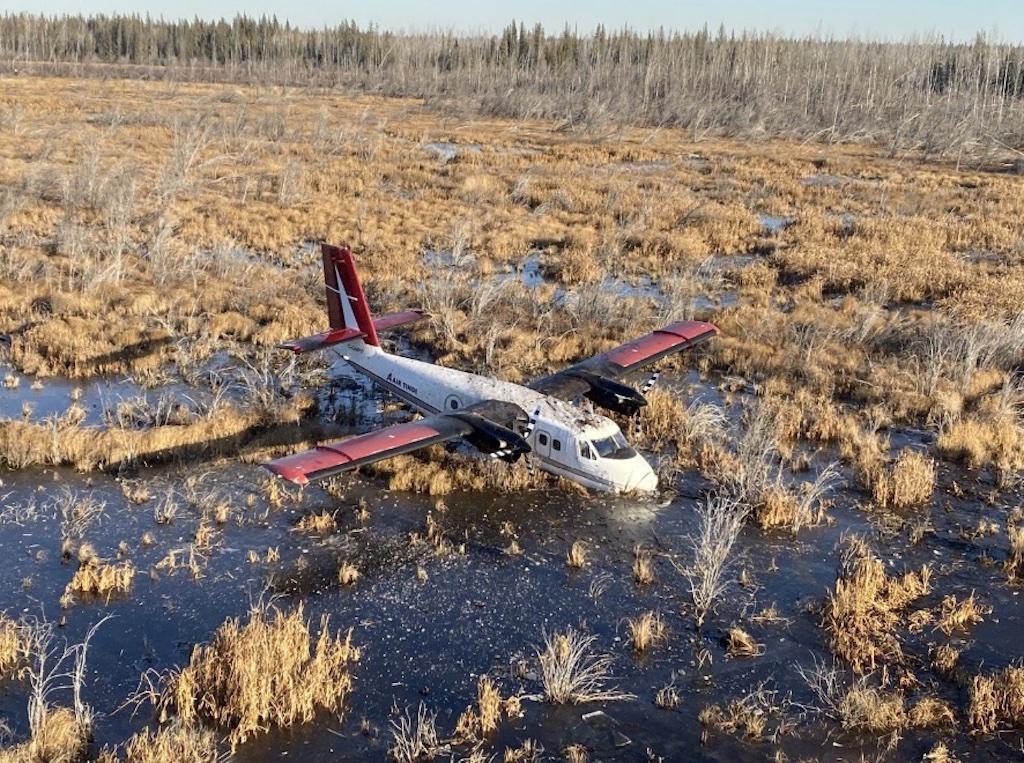
The Air Tindi DHC-6-300 Twin Otter landed in a watery peat bog called a 'muskeg' in Canada.
Fuel exhaustion accidents are common in general aviation. They are far less common in commercial, professionally flown operations. The NTSB database shows 669 fuel exhaustion-caused events, but only 10 of those took place in Part 135 operations. One significant reason for better fuel management by professionals is the use of checklists. Checklists are available in Part 91 operations, but they are required in Part 135 operations.
It is therefore notable and somewhat surprising to see the reasons why professionally flown aircraft run out of fuel. A number of recent Part 135 fuel exhaustion events were caused by older, very-high-time pilots who were just overconfident in their ability to stretch their fuel supplies. They knew how much fuel they had—and proceeded anyway. No checklist could help a pilot in a situation like that.
More common are cases where pilots rushed through their flight preparations and did not use a checklist to verify the fuel load, even though they were supposed to. Typically, they had just decided to stop using their normal checklist.
Why do pilots who should know better quit using their checklists? A 2021 accident in Canada provides a classic example.
Air Tindi flight TIN223 departed Yellowknife Airport (CYZF) at 17:48 MDT on Nov. 1, 2021. There were two pilots and three passengers onboard, and the VFR flight was conducted under Canadian Air Regulations (CAR) Part 703, Air Taxi Operations. The airplane was a de Havilland DHC 6-300 Twin Otter, registered as C-GNPS. The destination was Fort Simpson Airport (CYFS), 196 nm (225 mi.) away. The planned fuel for the fight was 2,500 lb.
The fuel onboard at the time of departure was 533 lb. No fuel truck showed up after the airplane landed, and the two pilots went into the terminal. When they returned, the captain noticed an old fuel slip stuffed into a door pocket and assumed it was for the next flight. It was not—and he did not check the slip. At 17:50, the fuel truck operator called the Air Tindi flight coordinator to ask if the flight needed fuel. The coordinator told him the flight had already left.
Twenty-five minutes after they departed, a low-fuel-level caution light should have come on. At that time, there was still 60 gal. of fuel onboard, enough to fly for 40 more minutes at cruise power. However, the pilots did not see the low-fuel light until 18:26, 38 min. after takeoff. They diverted to the nearest airport—Fort Providence Aerodrome (CYJP). They shut down the left engine and feathered the prop to conserve fuel and began a slow descent. At 18:43, 11 nm from CYJP and passing 3,300 ft., the right engine quit. The captain chose a flat area and landed at 18:51, just 6.7 nm from the airport.
The area they landed in was a cold, watery peat bog called a “muskeg” in Canada. Damage to the airplane was limited to the nose bulkhead, nose landing gear, nose skins and nose structure. There were no injuries initially, but everyone experienced hypothermia before they were rescued.
Air Tindi had 14 normal checklists in addition to its cockpit and cabin preparation checks. Three of them—the Before Start, Taxi and Cruise checklists—required that fuel quantity be verified. On the Before Start checklist, the captain interrupted his own checklist to talk to a passenger, and skipped over the fuel item. He ran the Taxi checklist alone, silently and from memory, and again missed the fuel. The first officer (FO) did not challenge him. The FO ran the Cruise checklist silently and without using the list.
A senior investigator from the Transportation Safety Board of Canada (TSB) gave two main explanations for the failure of the pilots to properly use their checklists. The first was the development of informal procedures, which he called “adaptation.” Pilots may experiment with boundaries to become more productive, focusing on the achievement of a goal instead of focusing on a threat. When they take higher-risk actions and there are no repercussions, they become habituated to the risk.
The investigator found that several of the senior captains at the company had developed the unsafe practice of doing checklists from memory, and this had become routine for them.
The second explanation was group dynamics and influence. Individuals may be unaware of when they have been influenced by other people. They may do things they would not normally do. They are influenced by experience, seniority, personality, social status or motivation. Examples of influence include compliance, conformity and group-think.
The FO had been hired in April 2021, and had been released to line flying for only two months when the accident occurred. His total time on the DHC-6 was 84.9 hr. The captain, on the other hand, had been with the company for 13 years, had more than 2,900 hr. in the airplane and was a training pilot.
The FO and several other new FOs knew and discussed the fact that some senior captains had developed the practice of doing challenge and response checklists silently, by memory and by themselves. They discussed this with some training captains, but did not submit any safety reports about it. They knew the company continued to pass these captains on checks without comment.
The pilots were at fault, but the company let this happen. Company managers like the chief pilot and director of training should be diligent about enforcing procedural compliance.
It is not enough to sit back and wait for safety reports to come in. Well-run companies are strict about procedure. Checklists are the backbone of procedure. Running them right should be a high emphasis item—all the time. The payoff for good checklist discipline is a better safety record.
To read more about good checklist design and use, see FAA Advisory Circular AC 120.71B, Standard Operating Procedures and Pilot Monitoring Duties for Flight Deck Crewmembers.





